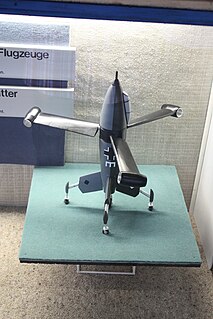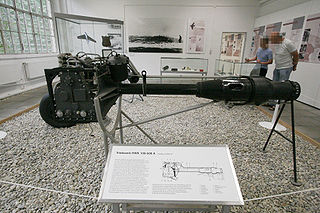
The Messerschmitt Me 163 Komet is a German interceptor aircraft designed for point-defence. It is the only operational rocket-powered fighter aircraft in history and the first piloted aircraft of any type to exceed 1,000 kilometres per hour (620 mph) in level flight. Designed by Alexander Lippisch, its performance and aspects of its design were unprecedented. In early July 1944, German test pilot Heini Dittmar reached 1,130 km/h (700 mph), an unofficial flight airspeed record unmatched by turbojet-powered aircraft until 1953.

JATO is a type of assisted take-off for helping overloaded aircraft into the air by providing additional thrust in the form of small rockets. The term JATO is used interchangeably with the term RATO, for rocket-assisted take-off.

The Bachem Ba 349 Natter was a World War II German point-defence rocket-powered interceptor, which was to be used in a very similar way to a manned surface-to-air missile. After a vertical take-off, which eliminated the need for airfields, most of the flight to the Allied bombers was to be controlled by an autopilot. The primary role of the relatively untrained pilot was to aim the aircraft at its target bomber and fire its armament of rockets. The pilot and the fuselage containing the rocket motor would then land using separate parachutes, while the nose section was disposable.

The Arado Ar 234 Blitz was the world's first operational jet-powered bomber, built by the German Arado company during World War II.

The Heinkel He 176 was a German rocket-powered aircraft. It was the world's first aircraft to be propelled solely by a liquid-fueled rocket, making its first powered flight on 20 June 1939 with Erich Warsitz at the controls. It was a private venture by the Heinkel company in accordance with director Ernst Heinkel's emphasis on developing technology for high-speed flight. The performance of the He 176 was not spectacular, but it did provide "proof of concept" for rocket propulsion.

The Messerschmitt Me 263 Scholle (plaice) was a rocket-powered fighter aircraft developed from the Me 163 Komet towards the end of World War II. Three prototypes were built but never flown under their own power as the rapidly deteriorating military situation in Germany prevented the completion of the test program.

The Mitsubishi J8M Shūsui was a Japanese World War II rocket-powered interceptor aircraft closely based on the German Messerschmitt Me 163 Komet. Built as a joint project for both the Navy and the Army Air Services, it was designated J8M (Navy) and Ki-200 (Army).

The DFS 228 was a rocket-powered, high-altitude reconnaissance aircraft designed by the Deutsche Forschungsanstalt für Segelflug during World War II. By the end of the war, the aircraft had only flown in the form of two unpowered prototypes.

The DFS 346 was a German rocket-powered swept-wing aircraft which began development during World War II in Germany. It was designed by Felix Kracht at the Deutsche Forschungsanstalt für Segelflug (DFS), the "German Institute for Sailplane Flight". A prototype was constructed but did not reach completion before the end of the war. It was taken to the Soviet Union where it was completed, tested and flown.

The Focke-Wulf Triebflügel, or Triebflügeljäger, literally meaning "thrust-wing hunter", was a German concept for an aircraft designed in 1944, during the final phase of World War II as a defence against the ever-increasing Allied bombing raids on central Germany. It was a vertical take-off and landing tailsitter interceptor design for local defense of important factories or areas which had small or no airfields.

The Emergency Fighter Program was the program that resulted from a decision taken on July 3, 1944 by the Luftwaffe regarding the German aircraft manufacturing companies during the last year of the Third Reich.

The Walter HWK 109-509 was a German liquid-fuel bipropellant rocket engine that powered the Messerschmitt Me 163 Komet and Bachem Ba 349 aircraft. It was produced by Hellmuth Walter Kommanditgesellschaft (HWK) commencing in 1943, with licensed production by the Heinkel firm's facilities in Jenbach, Austria.

The Focke-Wulf Flitzer was a jet fighter under development in Germany at the end of World War II.

The Leduc 022 was the prototype of a mixed-power French interceptor built in the mid-1950s. Designer René Leduc had been developing ramjet-powered aircraft since before World War II and had flown a series of experimental aircraft, the Leduc 0.10 and Leduc 0.21, throughout the Fifties before he was awarded a contract for two examples of a short-range supersonic interceptor armed with two air-to-air missiles (AAMs).
The DFS 332 was an experimental aircraft, built by the Deutsche Forschungsanstalt für Segelflug (DFS).

The Arado E.381 was a proposed parasite fighter aircraft. Conceived by Arado Flugzeugwerke in December 1944 for Germany's Luftwaffe during World War II, the E.381 was to have been carried aloft by and launched from an Arado Ar 234 "mother" aircraft. It would then have activated its rocket engine, which would have propelled it to attack Allied bombers. Development was cancelled due to lack of funds and official support.

The Focke-Wulf Volksjäger, meaning "People's Fighter" in German, was a German emergency fighter project for the Luftwaffe. It was designed by Focke-Wulf industries towards the end of World War II as part of the defense effort against the devastating Allied bombing raids.
The Heinkel P.1080 was a German Emergency Fighter proposed by Heinkel.
The SNCAC NC.271 was a French experimental aircraft built by SNCAC in the late 1940s, as a 1:2.5 scale model of the proposed SNCAC NC.270 jet bomber, featuring swept-back wings, using SNCASE SE-161 Languedoc N0.31 F-BCUT as a launch platform.
The Messerschmitt P.1103 Panzerjäger and P.1104 were a series of rocket-powered interceptors proposed by Messerschmitt.

















